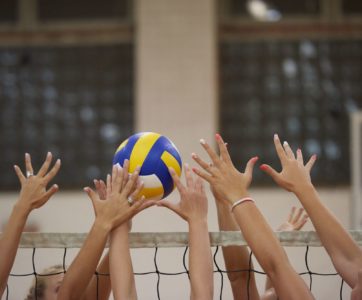 Volleyball is growing in popularity in the United States, and more high schools are adding the sport to their schedules. As more athletes jump into the sport, more athletes also end up in a doctor’s office with a foot or ankle injury. Based on the nature of the game, foot and ankle injuries are actually the most common injury in volleyball players.
Volleyball is growing in popularity in the United States, and more high schools are adding the sport to their schedules. As more athletes jump into the sport, more athletes also end up in a doctor’s office with a foot or ankle injury. Based on the nature of the game, foot and ankle injuries are actually the most common injury in volleyball players.
The traditional school of thought in the sports medicine world is that most foot and ankle injuries that occur in volleyball happen when the foot is in the plantarflexed position (when your heel is raised off the ground and your weight is forward on the balls of your feet). However, new research suggests that might not be the case.
Injuries While Blocking
According to new research presented earlier this week in the British Journal of Sports Medicine, video analysis of volleyball injuries show that plantarflexed position injuries aren’t the most common cause of injury. Instead, the biggest culprit is when a player lands after attempting to block a shot.
For their study, researchers analyzed videos of 24 injuries from major International Volleyball Federation tournaments involving both men and women. High-tech cameras allowed researchers to determine the specific situations and mechanisms involved leading up to and at the moment of injury. Although they only studied a small set of injuries, it was clear that blocking led to the majority of injuries (15). Attacking led to six injuries, and their were three “other” ankle injuries.
When a defending team attempts to block a shot from the attacking team, there are two factors that are almost always present, and they directly increase a person’s likelihood of suffering a foot injury:
- The defender is attempting to block a spike attempt, which occurs close to the net. This means the opponent is also in a close vicinity, separated only by a net they cannot touch. However, their feet will land very near to each other.
- To cover more area, blocks often involve more than one defender jumping in the same area to attempt to block the shot. So now there are often three people in a very small area competing for landing space.
Here’s what researchers wrote about the blocking injuries they observed.
“When landing on an opponent under the net, the attacker landed into the opponent’s court in 11 of 12 situations, but without violating the center line rule. Injuries mostly resulted from rapid inversion without any substantial plantarflexion,” researchers wrote. “The majority of injuries occur while blocking, often landing on an opponent.”
So while ankle guards and braces can help prevent you from rolling your ankle while moving laterally on the volleyball court, it appears that teams and players could benefit from jumping and landing technique training when attempting to block a shot. A brace isn’t going to do much when the force of your weight is coming down on your foot that is in an awkward position because it landed on another foot. Only technique training and spatial awareness can help prevent these types of injuries.